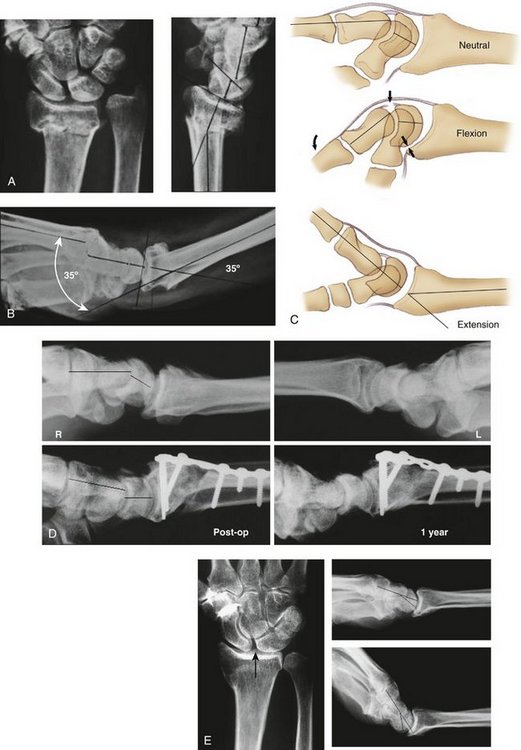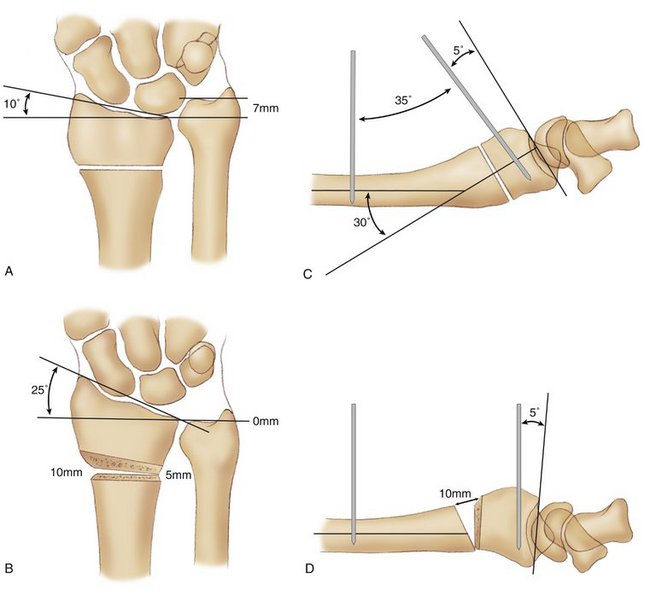CHAPTER 56 Osteotomy for Extra-articular Malunion of the Distal Radius
Distal radius fractures, first described in the 18th century by Petit1 and Pouteau2 commonly account for 10% of all fractures3 and 72% of all forearm fractures.4 For most authors, the most common complication of distal radius fractures is malunion, with a prevalence that ranges from 5% to 70% of all distal radius fractures, depending on the articles reviewed.5–12
Etiology and Pathophysiology
Approximately 25% of distal radius fractures treated by closed means heal with deformities that exceed general parameters of acceptance (dorsal tilt of 20 degrees in the sagittal plane and 10 degrees in the coronal plane, <10 degrees of rotation, <2 mm radial shortening, and <2 mm intra-articular step-off).8,9,11,13–16 When these fractures are treated by surgical means, however, regardless of the stabilization method employed, the incidence rate of malunion decreases to 10% or less.16,17 As a result, almost 80% of corrective osteotomies for malunion of the distal radius are done after failed closed treatment, and the remaining 20% are done after failed osteosynthesis, usually procedures done with minimally invasive techniques, such as external fixators or percutaneous Kirschner wires (K-wires).5,8,9,11,14,15,18–21
Diagnosis, Indications, and Timing
The need for surgical correction is multifactorial. Wrist deformity after fracture, even when exceeding the previously mentioned parameters of acceptance, may or may not produce symptoms. Differentiating symptomatic from asymptomatic malunion is paramount to decide whether treatment is necessary. Adequate, painless wrist function can be expected despite radiographic evidence of deformity, shortening, and degenerative changes. By necessity, the surgical decision is based on limitation of joint motion, grip strength, level of pain, and degree of cosmetic deformity. The intensity of these symptoms and their relative impact on activities of daily living, as correlated with radiocarpal radiographic findings, help define deformity tolerance and indications for corrective surgery.5,7,8,16,22
Pain
A malunited radius fracture may be a source of pain for various and often overlapping reasons, each of which must be assessed carefully because each sheds relevance in the selection of treatment. Intra-articular incongruence, be it at the radiocarpal joint or DRUJ, can produce early and often incapacitating pain.7,23,24 Loss of radial length can result in ulnocarpal abutment and may be a source of ulnar-sided wrist pain. Depending on the integrity of the distal radioulnar ligaments (volar and dorsal) of the triangular fibrocartilage complex, the abutment pain may be associated with limited forearm rotation (ligaments intact) or an unstable DRUJ (ligaments disrupted).25–27 A significant dorsal deformity (>20 to 30 degrees in the sagittal plane) displaces the proximal carpal row dorsally and overloads the articular cartilage in this reduced surface area (Fig. 56-1). Not only is this a common source of pain, but it also has been considered a prearthritic condition.28,29

FIGURE 56-1 A, Malunited Pouteau-Colles fracture with severe dorsal tilt of the joint surface. Notice dorsal subluxation of the carpus without intercarpal malalignment. B, Dorsally displaced flexion-extension arc of motion.
Capsular contractures and synovitis that result from positional abnormalities within the carpal rows are responsible for painful limitation of wrist flexion. At the midcarpal articulation, a dorsally malunited fracture can result in several distinct problems and compensatory deformities: (1) an adaptive (type I) dorsal intercalated segment instability (DISI), in which the midcarpal flexion is lax and fully correctable by radial osteotomy (Fig. 56-2A-D)30,31; (2) a fixed (type II) DISI malalignment, which does not improve after radial osteotomy and may represent a chronic stage of scapholunate instability, not diagnosed at the time of injury, or the stiffening with time of a previously lax deformity (Fig. 56-2E)9,30,32; and (3) the already mentioned dorsal subluxation of the entire carpus.25 Differentiating DISI types I and II can be done with a lateral x-ray of the wrist taken in the same amount of extension as the dorsal angulation of the malunited distal radius (see Fig. 56-2).30,32
Grip Strength
Another important parameter when deciding whether a corrective osteotomy is indicated is the loss of grip strength. Grip strength, when compared with the uninjured side or with cohorts of the healthy general population, often represents the degree of deformity and the associated functional impairment.33 Although there is no generally established quantity of weakness to warrant an osteotomy, it is thought that a grip of at least 30 kg is needed for most activities of daily living.34 In addition to the loss of strength secondary to pain, the spatial angulations that result from malunion alter the flexor and extensor tendinous vectors of traction.7 The change in position of the wrist’s center of rotation results in diminished efficiency of the tendon lever arms.
Range of Motion
The third evaluation criterion for corrective osteotomy is limitation of joint motion. Malunions with intra-articular incongruity greater than 2 mm have considerable limitations in range of motion.23,24 It is common to have less than 40 degrees in extension or supination or both in a Smith fracture and flexion of only 30 degrees in a Colles’ fracture.32 Limited motion may be severe enough to indicate a corrective osteotomy alone, despite adequate grip strength and absence of pain. When combined with pain and weakness, decreased function significantly limits activities of daily living.
Cosmetic Appearance
For certain patients, malunion deformity may be so obvious that esthetic considerations may incline the surgeon toward correction despite nonsuggestive functional and radiographic parameters. An isolated deformity does not justify corrective osteotomy.7,16,22 Regardless, it is rare for such deformities to occur in the absence of symptoms.
Radiographic Findings
My colleagues and I do not believe in the use of fixed radiographic angles for determining if correction is needed. Certain parameters that are associated with rapid degenerative changes, such as an articular incongruence greater than 2 mm or the prearthritic deformity of a dorsal defect greater than 20 to 30 degrees, are considered formal surgical indications, independent of patient symptoms, especially in a young patient. Lanz and Kron35 suggest comparisons of the affected wrist with statistical radiographic standards to quantify amount of deformity.3,15,22,36 In contrast, a comparison tailored to the patient’s particular anatomy can be obtained with radiographs of the uninjured wrist, as suggested in an earlier work.7
Timing
Although correction of extra-articular deformity can be safely delayed until the soft tissues offer an ideal surgical environment, and maximal residual function of the wrist has been regained, intra-articular deformity should be dealt with as soon as possible, before irreversible articular damage occurs. Jupiter and Ring37 compared the results of early and late osteotomies in two similar cohorts and concluded that early correction provided easier radial and DRUJ realignment because of the absence of soft tissue and capsular contractures. The need for structural iliac crest bone graft is diminished because the local nascent callus material can be used to fill defects. Jupiter and Ring37 concluded that although functional results are similar in both groups, early surgery resulted in considerably less total disability and earlier return to work.
Surgical Correction of Extra-articular Dorsal Deformity: Management Options
Dorsal Approach
Preoperative Planning
A careful preoperative plan incorporating K-wires that mark the angles of correction is characteristic of this technique (Fig. 56-3). These angles are mandatory to simplify the procedure, guarantee an accurate angular correction, and diminish the need for intraoperative image control. Prerequisites for this planning process are standard radiographs of the injured and uninjured side. When superimposed, these images allow localization of the osteotomy site and measurement of angular deformity in the two orthogonal projections: the lateral view (sagittal plane) and the anteroposterior view (frontal plane).









